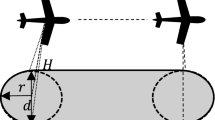Abstract
Multiple Uninhabited Aerial Vehicles (multi-UAVs) coordinated trajectory replanning is one of the most complicated global optimum problems in multi-UAVs coordinated control. Based on the construction of the basic model of multi-UAVs coordinated trajectory replanning, which includes problem description, threat modeling, constraint conditions, coordinated function and coordination mechanism, a novel Max-Min adaptive Ant Colony Optimization (ACO) approach is presented in detail. In view of the characteristics of multi-UAVs coordinated trajectory replanning in dynamic and uncertain environments, the minimum and maximum pheromone trails in ACO are set to enhance the searching capability, and the point pheromone is adopted to achieve the collision avoidance between UAVs at the trajectory planner layer. Considering the simultaneous arrival and the air-space collision avoidance, an Estimated Time of Arrival (ETA) is decided first. Then the trajectory and flight velocity of each UAV are determined. Simulation experiments are performed under the complicated combating environment containing some static threats and popup threats. The results demonstrate the feasibility and the effectiveness of the proposed approach.
Similar content being viewed by others
References
Beard R W, Mclain T W, Goodrich M A, Anderson E P. Coordinated target assignment and intercept for unmanned air vehicles. IEEE Transactions on Robotics and Automation, 2002, 18, 911–922.
Ben-Asher Y, Feldman S, Gurfil P, Feldman M. Distributed decision and control for cooperative UAVs using Ad Hoc communication. IEEE Transactions on Control Systems Technology, 2008, 16, 511–517.
Cowlagi R V, Tsiotas P. Multiresolution path planning with wavelets: A local replanning approach. Proceedings of American Control Conference, Washington, USA, 2008, 1220–1225.
Chen Y M, Chang S H. An agent-based simulation for multi-UAVs coordinative sensing. International Journal of Intelligent Computing and Cybernetics, 2008, 1, 269–284.
Zheng C W, Ding M Y, Zhou C P. Cooperative path planning for multiple air vehicles using a co-evolutionary algorithm. Proceedings of the First International Conference on Machine Learning and Cybernetics, Beijing, China, 2002, 219–224.
Zucker M, Kuffner J, Branicky M. Multipartite RRTs for rapid replanning in dynamic environments. Proceedings of IEEE International Conference on Robotics and Automation, Roma, Italy, 2007, 1603–1609.
Beard R W, Mclain T W. Multiple UAV cooperative search under collision avoidance and limited range communication constraints. Proceedings of IEEE Conference on Decision and Control, Hawaii, USA, 2003, 25–30.
Mclain T W, Beard R W. Coordination variables, coordination functions, and cooperative-time missions. Journal of Guidance, Control, and Dynamics, 2005, 28, 150–161.
Colorni A, Dorigo M, Maniezzo V. Distributed optimization by ant colonies. Proceedings of European Conference on Artificial Life, Paris, France, 1991, 134–142.
Dorigo M, Gambardella L M. Ant colony system: A cooperative learning approach to the traveling salesman problem. IEEE Transactions on Evolutionary Computation, 1997, 1, 53–66.
Dorigo M, Maniezzo V, Colorni A. The ant system: Optimization by a colony of cooperating agents. IEEE Transactions on Systems, Man, and Cybernetics-Part B, 1996, 26, 29–41.
Bonabeau E G, Dorigo M, Theraulaz G. Inspiration for optimization from social insect behavior. Nature, 2000, 406, 39–42.
Duan H B. Ant Colony Algorithms: Theory and Applications, Science Press, Beijing, China, 2005. (in Chinese)
Duan H B, Wang D B, Yu X F. Grid-based ACO algorithm for parameters tuning of NLPID controller and its application in flight simulator. International Journal of Computational Methods, 2006, 3, 163–175.
Duan H B, Ding Q X, Chang J J. Multi-UCAVs Task assignment simulation platform based on parallel ant colony optimization. Acta Aeronautica ET Astronautica Sinica, 2008, 29, s192–s197. (in Chinese)
Duan H B, Yu Y X, Zhou R. UCAV path planning based on Ant Colony Optimization and satisficing decision algorithm. Proceedings of IEEE Congress on Evolutionary Computation, Hong Kong, 2008, 957–962.
Liu C G, Li W J, Wang H P. Path planning for UAVs based on ant colony. Journal of Air Force Engineering University, 2004, 2, 9–12. (in Chinese)
Ma G J, Duan H B, Liu S Q. Improved ant colony algorithm for global optimal trajectory planning of UAV under complex environment. International Journal of Computer Science and Applications, 2007, 4, 57–68.
Yu Y X, Duan H B, Zhang X Y. Three-dimension path planning for UCAV using hybrid meta-heuristic ACO-DE algorithm. Proceedings of Asia Simulation Conference—7th International Conference on System Simulation and Scientific Computing, Beijing, China, 2008, 919–924.
Zheng C W, Li L, Xu F J, Sun F C, Ding M Y. Evolutionary route planner for unmanned air vehicles. IEEE Transactions on Robotics, 2005, 21, 609–620.
Ye Y Y, Min C P. A co-evolutionary method for cooperative UAVs path planning. Computer Simulation, 2007, 24, 37–39. (in Chinese)
Chandler P R, Rasmussen S, Pachter M. UAV cooperative path planning. Proceedings of the AIAA Guidance, Navigation and Control Conference, Denver, CO, 2000, AIAA-2000-4370.
Xiao Q K, Gao X G. Study on a kind of local path replanning algorithm for UAVs. Journal of Air Force Engineering University, 2006, 24, 67–80. (in Chinese)
Thomas S, Holger H H. Max-Min ant system. Future Generation Computer Systems, 2000, 16, 889–914.
Author information
Authors and Affiliations
Corresponding author
Rights and permissions
About this article
Cite this article
Duan, Hb., Zhang, Xy., Wu, J. et al. Max-Min Adaptive Ant Colony Optimization Approach to Multi-UAVs Coordinated Trajectory Replanning in Dynamic and Uncertain Environments. J Bionic Eng 6, 161–173 (2009). https://doi.org/10.1016/S1672-6529(08)60113-4
Published:
Issue Date:
DOI: https://doi.org/10.1016/S1672-6529(08)60113-4




